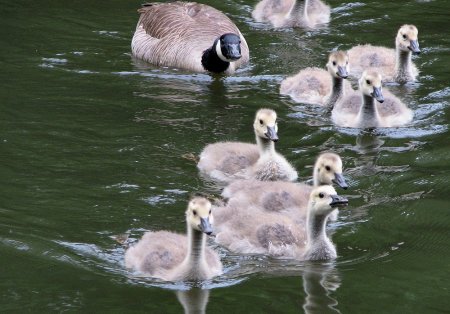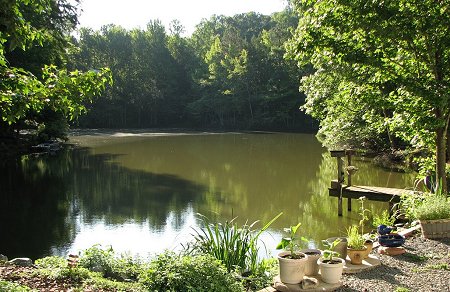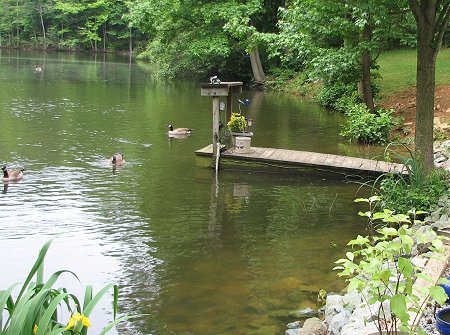Tag: ponds
TGIF@ Rose Cottage
by admin on May.24, 2013, under Images
Busy, busy times but I did manage to get a updated photo of some of the goslings yesterday:

Another inch+ of rain during the week really has the lake looking better for water level than it has in the last 4 or 5 years.
Here’s a shot showing the dock first week of June 2012:

And here it is – yesterday:

Hard to tell from the pictures but this is nearly a foot higher water level than last year.
Thought I heard the first Hummingbird yesterday but didn’t see it. Time to get those feeders out! And a good time to enter the Duncraft sweepstakes…Win $250 Duncraft Shopping Spree – Enter here at duncraft.com.
Plant Life for Garden Ponds – A Guide
by admin on Mar.23, 2013, under Favorites, Real Estate
Stocking your garden pond with the right kind of plant life is not only an exercise in aesthetics, but it’s also essential for the health of the water and any marine life within it. Locating your pond in a sunlit area will help the lifespan of your greenery, whilst setting it in early spring will give your plants the best chance of becoming established. You should endeavour to make at least a small area of your pond a meter or more in depth to provide shelter for pond life in very hot or cold weather.

Plants to Encourage
Bog plants are well suited to the marshy soil around the borders of the pond, conditions which can be enhanced by extending the pond liner under the first few feet of soil around the pond. Primula, water mint, horse tails and rushes grow well here.
Shallow water marginal plants include irises, rushes and sedges. Taller, grass like plants such as Sweet Flag and Baumea provide attractive greenery at the borders of a pond, and flowering plants like Baldellia and Buttercups provide colour. In deeper margins, flowering plants such as Pontederia Dilatata or Royal Pickeral, Sagittaria and larger rushes thrive. If you have a very large pond and want something spectacular, the South American Gunnera, which can grow up to 3 meters in height with a 4 meter spread, makes a showy statement.
Depending on the size of your pond, lilies and other deep water plants such as Nymphoides Peltata add interest, but these require an absolute minimum of two meters in depth. For smaller ponds, Pygmy water lilies are ideal.
Floating plants provide cover for fish and look wonderful even in smaller ponds, although it’s very important to select a species that will be happy with the space you have available. While some floating plants can go on to become rampant pests in open waterways, most can be controlled with proper care within the confines of a small pool. Salvinia has pretty bright green leaves, Water Hyacinths, which have rubbery foliage and delicate flowers, are also a good addition, as are rare natives like Stratiotes aloides. It’s important not to let deep water plants get too large, as they can take up too much oxygen.
Your pond will need oxygenators to provide food and cover for wild life as well as adding oxygen to the pond. Plants that grow too vigorously can upset the balance, so care must be taken here. Pondweeds, some of which produce small surface flowers in the summer, are a good start. Water Starwort has star-shaped rosettes of oval leaves that provide cover for aquatic insects, although it can be a little tricky to establish, Spike Rushes will do well in shallower ponds, and Water Violets produce beautiful tall flower stems.

Plants to Avoid
Some plants are best avoided, as they can grow rapidly and engulf the pond. Stay well clear of species like Water Primrose, Water Fern, Parrots Feather, New Zealand Pigmyweed, Floating Pennywort, Curly Waterweed, Canadian Pondweed and Nuttalls Pondweed. Unfortunately, additions of these plants are not always intentional, as ponds can be infected when water is transferred between them, or when water from an outside watercourse enters the pond. Look out for fast growing plants that you don’t remember planting, and if a plant appears to be taking over, identify it and research proper removal techniques for that species. If in doubt, DEFRA provides fact sheets and information on most invasive species.
Planting
In lined ponds, the best way to incorporate plants is to settle them into aquatic baskets. Use larger baskets for taller plants. Use aquatic potting soil, never regular potting compost, and top baskets off with gravel without burying the plant’s leaves. Water in well and gently lower the basket to its final position – larger plants may need to be moved down gradually as they grow.
Nurturing your Pond
Ponds that smell strongly are likely to be oxygen deficient and full of decaying matter, fish gulping near the surface or near water streams also indicate low oxygen levels. Vigorous algal growth means that there is too much carbon dioxide in the water. As well as looking out for these signs, it’s worth doing the occasional oxygen test and adding water balancers if needed. You can also use an aeration device such as a fountain to increase oxygenation.
Marginals need to be re-potted annually. Lift them gently from the water and remove any hitch-hikers. These plants can have very fragile roots, so take care not to damage them. For plants that grow in clumps, carefully remove and divide them into new, hessian lined pots. Regularly sieve out algae if it is growing too quickly and remove overgrown pondweed with a rake.
Prepare your pond for winter by cutting back vegetation to prevent falling leaves from accumulating in the pond and rotting, and remove fallen leaves periodically. Turn off fountains to reduce water disturbance, as fish will seek out warmer water at the bottom of the pond. If it freezes over, make holes using warm water (do not shatter the ice as it will cause shockwaves that disturb fish) to allow oxygenation. Switch to winter fish food such as wheatgerm pellets, as fish do not digest protein easily in cold weather.
Author: This post was written by Walter Bucket, the home and garden blogger from UK Water Features. When he’s not pondering over his ponds at home, he can be found designing garden wall art and topiary balls for gardens around the UK.
Pond Maintenance – Get an early start!
by admin on Mar.19, 2010, under Quick Deals!
Aquasphere, 225,000 gal
Not for large ponds and lakes, but a great way to get a jump-start on a cleaner small pond or water feature Summer 2010.
Keep your pond fresh and clear with the cleansing power of beneficial bacteria and enzymes. Regardless of how large your pond is (up to 225,000 gallons), the Aquasphere will clean it for a full 30 days. Easy to use, reducing excess nutrients and breaking down organic matter that clouds water. Choice of two sizes: 50,000 gallons and 225,000 gallons.
Non-toxic and safe for fish, pets and aquatic plants. Use when water temperature is 50 degrees or warmer Measures 6″ diameterand is recyclable, not refillable. Unfortunately, not for control of duckweed.
To calculate your pond gallons: Length (in feet) x width x average depth x 7.5 = gallons.


